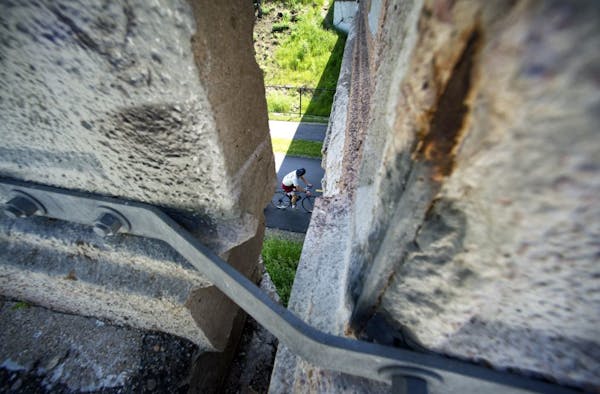The century-old bridges that carry streets over Minneapolis' Midtown Greenway could face $40 million worth of repairs or replacement, a cost that has Hennepin County leaders asking whether some should just be torn down.
After the 103-year-old Fremont Avenue Bridge was closed to cars this month because of safety concerns, county leaders moved forward with plans to spend $1.2 million to build a new bridge, part of an estimated $4 million price tag.
But it's spurred a larger discussion about the fate of the historic bridges that line the old railroad corridor, owned by the Hennepin County Regional Railroad Authority, with some county commissioners saying as many as half the bridges could be closed permanently.
"You don't need access on every block," Commissioner Mike Opat said. "It's not prudent to spend $4 million on a bridge ... a significant number of them could be torn down."
It comes at a time when the state Department of Transportation is studying whether the historic district status should be rescinded as the character of the area evolves.
The Midtown Greenway, a trail that stretches nearly 6 miles across Minneapolis, is a popular link for bicyclists and pedestrians. Of 37 bridges that cross the trenched corridor, 27 are originals, nearly identical neoclassical-style bridges built between 1912 and 1917.
Now, as repairs come up for the aging bridges, questions over who should pay for repairs or replacement is prompting a larger look at whether bridges should even stay open.
"Clearly, in my mind, we don't want to be replacing every bridge on every block," Opat said.
At a meeting this month of the Regional Railroad Authority, which is made up of county commissioners, staff was asked to develop a plan for a strategy on addressing the rest of the bridges instead of taking a project-by-project approach.
The railroad authority owns the former railroad corridor and its bridges, but both city and county streets cross it.
Minneapolis City Council Member Lisa Bender, whose ward includes part of the Greenway, said she agrees with putting together a plan, but she said public feedback would be needed before considering shutting down bridges, which she said are valuable for pedestrians, bicyclists and local traffic in increasingly dense areas.
"I think that would be a very difficult conversation for the community," she said of tearing down bridges. "But I wouldn't start there."
A 2007 study by Minneapolis included looking at closing some bridges, but there were some concerns it would affect the traffic grid, city bridge engineer Jack Yuzna said.
Fixing Fremont
The fate of the bridges surfaced as the county moved forward with plans for the Fremont Avenue Bridge, which was built in 1913 and is the third bridge slated to be torn down and replaced, lowering the number of original bridges to 24. The other two bridges are at Cedar and Portland avenues.
Major changes to most of the historic bridges have to go through MnDOT and the state Historic Preservation Office, which agreed the two bridges are beyond repair, but said replacing them will adversely affect the historic district and recommended new bridges fit the historic character.
"It's always important to preserve our past; if you lose it, you just have a grassy trench," said Sarah Beimers of the State Historic Preservation Office.
A fourth bridge at Blaisdell Avenue doesn't have structural problems but doesn't fit the historic character, said Joe Gladke, the county's engineering and transit planning manager.
According to a Hennepin County and MnDOT study in 2015, it would cost $40 million to rehab all 27 bridges. But both city and county leaders have to agree on the next steps.
That complicated relationship emerged this month over Fremont, a city street over a county bridge. The city and county's Rail Authority plan to split costs, paying $1.2 million each, while $1.6 million in federal money would pay the rest of the estimated $4 million tab for design and construction.
The Fremont Bridge was closed to cars when inspections found that it was deteriorating. It's still open to bicyclists and pedestrians. If policymakers wanted to close bridges, Gladke said, Fremont wouldn't be one of them because of its high traffic count.
Rescinding historic status?
If more bridges are torn down or replaced, it could continue to affect the historic character of the Greenway.
A 2.8-mile stretch of the corridor from Humboldt Avenue to 28th Street was listed in the National Register of Historic Places in 2005. Since then, redevelopment has exploded, with new apartments and ramps added to the path.
All the changes prompted MnDOT to do a preliminary report, released in May, re-evaluating the historic designation. A final report is expected this fall.
"Every time a bridge gets removed, it impacts its integrity," said Kristen Zschomler, a MnDOT historian and archaeologist. "And we're not sure what that tipping point is."
It's not often sites are delisted, and it's very rare for a whole historic district to be delisted, Beimers said. Another option, Zschomler said, is to shrink the district to the side that's more intact.
"It's a very significant property that impacts a lot of levels of government ... does it still have [historic] integrity?" Zschomler said. "We're just raising the question."
If the designation were rescinded, it could mean more rapid replacement of historic places like bridges, she added.
"The historic bridges are part of what makes the Greenway iconic," said Soren Jensen of the Midtown Greenway Coalition.
The preservation office agreed, saying that the area still has a lot of historical significance.
"It's an important part of Minneapolis history," Beimers said. "You probably wouldn't have had the Greenway ... if that designation of the historic district hadn't happened."
Kelly Smith • 612-673-4141
Twitter: @kellystrib
Charge: Driver going 77 mph ran red light, fatally hit man crossing St. Paul street and kept going
Minnesota Senate GOP files ethics complaint against Sen. Nicole Mitchell
High school archer focuses on target: another national championship

